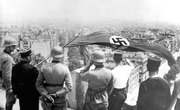Short stories are short works of fiction in which the characters and their lives are invented by the author. This genre is akin to poetry in that it doesn't possess the length of the novel to tell its story and make its point -- a short story requires a potency that can withstand the brevity of the form. When analyzing a story, a student must examine the characters, setting, plot, conflicts and themes. The analysis of these elements serves as the material for the essay about the story.
Characters
The characters are the people in a story who form the action that drives the plot forward. Because of the brevity of the form, short story writers must develop the relationships between characters quickly. Readers become familiar with the characters through their physical descriptions, thoughts, feelings, words and actions; readers also become familiar with the characters through the opinions and reactions they evoke in other characters. The point of view through which a story is narrated can limit or reveal aspects of each character. For example, if a story is told in the first person from the point of view of a particular character, access to the thoughts and motivations of other characters can be limited. When analyzing the characters, students should ask whether the character is a protagonist, antagonist, hero or villain. They should also examine what obstacles the characters face, how they deal with those obstacles and what their actions reveal about their values and beliefs.
Setting
The setting is the environment in which a story takes place and can include information about the geographical location, historical era, social and political conditions, weather, and time of day. The setting can have an enormous impact on character development, conflict and plot. For example, a writer could argue that in the short story "To Build A Fire" by Jack London, the protagonist's fate is determined by the physical environment -- the freezing cold Yukon Territory of Canada -- and his reactions to it.
Conflicts
The conflict is a struggle between two characters, a character and himself, two forces, or a character and a force. For example, a writer could argue that in "To Build a Fire," there is a conflict between the protagonist (a character) and nature (a force). In this short story, the protagonist is futilely trying to resist nature, represented by both the overwhelming cold and the instincts of his animal companion. A conflict in a story can reveal a character's weaknesses, strengths, values and perspectives.
Themes
Themes are a key element to writing an analysis essay about a story. The theme of a story references an idea, belief or universal aspect of the human condition. Some common literary themes that can be found in short stories include the American Dream, the cost of war, death and grieving, racism, community, the quest for identity, overcoming adversity, and the importance of family. The short stories that are published and taught in schools tend to contain more than one theme. For example, Shirley Jackson's story "The Lottery" includes the themes of fear and cowardice, dangerous traditions, human violence, and the indoctrination of youth. Often the essay's thesis statement is drawn from some aspect of a story's theme.
Related Articles
References
Writer Bio
Soheila Battaglia is a published and award-winning author and filmmaker. She holds an MA in literary cultures from New York University and a BA in ethnic studies from UC Berkeley. She is a college professor of literature and composition.











